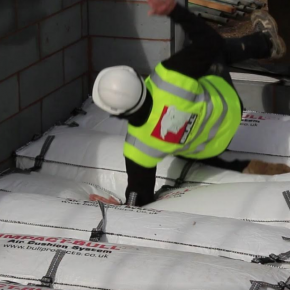
Bull Products covers the benefits of air-filled fall arrest bags
Bradley Markham, director at Bull Products, looks at the importance of enhancing site safety by investing in air-filled fall arrest bags.
In 2017/18, 35 fatal injuries to workers were due to falls from a height. According to HSE, falls from height still remain the main cause of fatal accident for workers, with the construction industry held accountable for the highest number.
Markham believes companies need to shift away from alternative methods such as birdcage scaffolding and guardrail systems to protect workers from falls from height, and start enhancing site safety by investing into air-filled fall arrest bags – below are some of his top reasons for investing in air-filled fall arrest bags:
1. Minimises risk of injury
The HSE states that a tower scaffold is recommended as one way to prevent a fall when working at height. However, many are poorly erected or misused, and if a worker was to fall from a height from a tower scaffold they would likely be majorly injured.
Fall arrest bags, on the other hand, minimise the risk of injury as they are designed to provide a safe cushioned landing, absorbing the weight of a fall without causing major injury.
2. Meets the needs of housebuilders
Fall arrest systems have been around since the late 1990s due to the large number of accidents with falls in the construction industry. The house building market had a high track record of accidents from contractors working on floor joist and roof trusses, where they had no protection from falling through one or two floors onto a concrete slab.
Fall arrest bags have been designed and tested to mitigate injury from falls from height and meet the needs of house builders. These types of systems can be used in timber framed developments, concrete buildings, traditional brick-built properties, scaffolding, lorry beds and much more.
3. Makes room for harness free
Using fall arrest bags, workers can confidently work harness-free – giving them greater freedom to move around and handle tools and materials.
4. Ease of installation and cost-effectiveness
For extra practicality, fall arrest bags are prefilled with pockets of air, making them far easier and quicker to install than birdcage scaffolding. They also provide a cost-saving solution. Installation time for a plot takes approximately 15 minutes using the air cushion systems. In addition, basic practical training and a simple theory test covers the installation method and sign off of fall arrest systems in contrast to that of a scaffolders qualification.
The Impact-Bull® Fall Arrest System has a fall arrest height of 3.1m from finished floor level to working height, a higher fall rating than any other fall arrest system on the market. The system can protect workers working in properties with higher ceilings, revolutionising the way construction at height operates.
Latest news

18th April 2024
Abloy UK showcases new digital portfolio at The Security Event 2024
Abloy UK is set to unveil its latest line-up of access control systems at The Security Event 2024, welcoming guests to explore its cutting-edge electromechanical and digital solutions on stand 5/F50.
Posted in Access Control & Door Entry Systems, Architectural Ironmongery, Articles, Building Industry Events, Building Industry News, Building Products & Structures, Building Services, Doors, Exhibitions and Conferences, Facility Management & Building Services, Health & Safety, Information Technology, Retrofit & Renovation, Security and Fire Protection
18th April 2024
Strand is a Failsafe Choice for Emergency Exit and Panic Hardware
In times of emergency, you’re in safe hands with Strand Hardware. Although there are many considerations for building specification, few decisions can be as critical as selecting the right emergency exit/panic hardware.
Posted in Access Control & Door Entry Systems, Architectural Ironmongery, Articles, Building Industry News, Building Products & Structures, Building Services, Doors, Facility Management & Building Services, Health & Safety, Restoration & Refurbishment, Retrofit & Renovation, Security and Fire Protection
18th April 2024
MRA appoints Callum Budd as Research Projects Director
MRA Research, the research agency focused solely on the construction sector, welcomes Callum Budd as its new Research Projects Director.
Posted in Articles, Building Industry News, Information Technology, news, Recruitment, Research & Materials Testing
16th April 2024
Mitsubishi Electric set to host CIBSE Journal webinar
Mitsubishi Electric will host a CIBSE Journal webinar on Wednesday 24th April 2024 at 1pm to discuss the legislation and initiatives driving changes in the way we will need to heat, cool and ventilate large commercial buildings to reach net zero emissions in the UK.
Posted in Air Conditioning, Articles, Building Industry Events, Building Industry News, Building Products & Structures, Building Regulations & Accreditations, Building Services, Facility Management & Building Services, Heating Systems, Controls and Management, Heating, Ventilation and Air Conditioning - HVAC, Information Technology, Pipes & Fittings, Plumbing, Seminars, Sustainability & Energy Efficiency, Training
 Sign up:
Sign up: